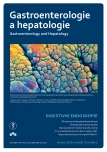Endoscopic management of sigmoid volvulus
Authors:
I. Mikoviny Kajzrlíková 1; P. Vítek 1,2; M. Chrostek 3
Authors place of work:
Beskydské gastrocentrum, Interní oddělení, Nemocnice ve Frýdku-Místku, p. o.
1; Lékařská fakulta OU v Ostravě
2; Chirurgicko-traumatologické oddělení, Nemocnice ve Frýdku-Místku, p. o.
3
Published in the journal:
Gastroent Hepatol 2016; 70(3): 217-219
Category:
Digestivní endoskopie: kazuistika
doi:
https://doi.org/10.14735/amgh2016217
Summary
We present a case report of a 37-year-old woman who was admitted for abdominal pain and nausea. Imaging showed the presence of a sigmoid volvulus, which was successfully treated by endoscopic reduction and insertion of a decompression tube. The mucosa of affected sigmoid colon showed no signs of bowel ischemia. Endoscopic reduction was followed by surgical resection of a 70 cm long section of the dolichosigmoid colon to prevent recurrence. Sigmoid volvulus is a relatively uncommon cause of intestinal obstruction in Western countries. It usually occurs in older patients with a history of chronic obstipation. Other risk factors are a long sigmoid colon and colonic dismotility. In patients who do not have clinical features suggestive of gangrene, sepsis, or perforation, endoscopic management is the preferred method and has a success rate 75–95%. The majority of authors recommend subsequent surgical resection because sigmoid volvulus reoccurs in 60% of patients not treated by surgery.
Key words:
intestinal volvulus – ileus – endoscopy – colorectal surgery
The authors declare they have no potential conflicts of interest concerning drugs, products, or services used in the study.
The Editorial Board declares that the manuscript met the ICMJE „uniform requirements“ for biomedical papers.
Submitted:
31. 3. 2016
Accepted:
18. 5. 2016
Zdroje
1. Weingrow D, McCague A, Shah R et al. Delayed presentation of sigmoid volvulus in a young woman. West J Emerg Med 2012; 13(1): 100– 102. doi: 10.5811/ westjem. 2011.4.6720.
2. Jones IT, Fazio VW. Colonic volvulus. Etiology and management. Dig Dis 1989; 7(4): 203– 209.
3. Hodin RA et al. Sigmoid volvulus. [online]. Available from: www.uptodate.com/ contents/ sigmoid-volvulus.
4. Krupsky S, Halevy A, Orda R. Sigmoid volvulus in adolescence. J Clin Gastroenterol 1987; 9(4): 467– 469.
5. Catalano O. Computed tomographic appearance of sigmoid volvulus. Abdom Imaging 1996; 21(4): 314– 317.
6. Hirao K, Kikawada M, Hanyu H et al. Sigmoid volvulus showing „a whirl sign“ on CT. Intern Med 2006; 45(5): 331– 332.
7. Watson RG. Ileosigmoid knot. J R Coll Surg Edinb 1984; 29(2): 100– 102.
8. Raveenthiran V, Madiba TE, Atamanalp SSet al. Volvulus of the sigmoid colon. Colorectal Dis 2010; 12 (7): e1– e17. doi: 10.1111/ j.1463-1318.2010.02262.x.
9. Oren D, Atamanalp S, Aydinli B et al. An algorithm for the management of sigmoid colon volvulus and the safety of primary resection: experience with 827 cases. Dis Colon Rectum 2007; 50(4): 489– 497.
10. Cowlam S, Watson C, Elltringham M et al. Percutaneous endoscopic colostomy of the left side of the colon. Gastrointest Endosc 2007; 65(7): 1007– 1014.
11. Cirrocchi R, Farinella E, La Mura F et al. The sigmoid volvulus: surgical timingand mortality for different clinical types. World J Emerg Surg 2010; 5: 1. doi: 10.1186/ 1749-7922-5-1.
12. Roseano M, Guarino G, Cuviello A. Sigma volvulus: diagnostic and therapeutic features (considerations on 10 cases). Ann Ital Chir 2001; 72(1): 79– 84.
Štítky
Dětská gastroenterologie Gastroenterologie a hepatologie Chirurgie všeobecnáČlánek vyšel v časopise
Gastroenterologie a hepatologie

2016 Číslo 3
- Metamizol jako analgetikum první volby: kdy, pro koho, jak a proč?
- MUDr. Lenka Klimešová: Multioborová vizita může být klíčem k efektivnější perioperační léčbě chronické bolesti
- Horní limit denní dávky vitaminu D: Jaké množství je ještě bezpečné?
- Realita léčby bolesti v paliativní péči v Německu
Nejčtenější v tomto čísle
- Stenóza tlustého střeva neobjasněné etiologie
- Mutaflor® – Escherichia coli (Nissle 1917), sérotyp O6:K5:H1 – nejlépe prozkoumané probiotikum současnosti
- Endoskopické řešení volvulu sigmatu
- Neuroendokrinní nádory v gastroenterologické praxi
